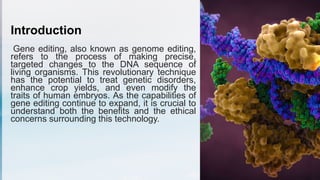Gene editing is a new technology that allows precise modifications to DNA sequences. It holds promise for treating diseases, enhancing crops, and modifying human embryos, but also raises complex ethical issues that require careful consideration. This presentation will explore both the technical aspects and far-reaching implications of gene editing from medical, agricultural, and societal perspectives, addressing concerns around safety, germline editing, and ensuring equitable access to its benefits.










